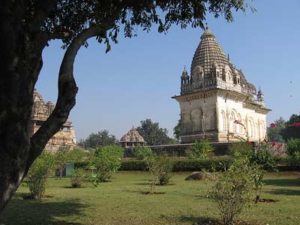
It is only a small matter of perspective. Those who visit Khajuraho temples wonder about the sexual motifs. Then there are those who have visited Konarak, Bhubaneswar and other lesser known temples. All built between 900 to 1400 AD. They wonder about the obsession with sexual motifs in temples of that period. Then there are also researchers of art in that period who wonder why all art and not only temples seem complete only with sexual motifs. All these people owe allegiance to varied perspectives – that of a tourist or layman or that of an artist, or that of claimants to spiritual idealism, or that of researchers of art or even psychologists.
 A few standard questions keep popping up in all these minds. For sex which is as taboo as it is, isn’t it paradoxical that it finds its way into religious buildings? Isn’t it more logical to expect religious ideology as expounded in the Upanishads and the Gita on temple – sculpture? Was this obsession with sex the whim or caprice of a few individuals of the period ? Is it all meant to be a How-to kind of manual ? Does it find itself manifested due to some popular mythology of a period about which little is known today ?
A few standard questions keep popping up in all these minds. For sex which is as taboo as it is, isn’t it paradoxical that it finds its way into religious buildings? Isn’t it more logical to expect religious ideology as expounded in the Upanishads and the Gita on temple – sculpture? Was this obsession with sex the whim or caprice of a few individuals of the period ? Is it all meant to be a How-to kind of manual ? Does it find itself manifested due to some popular mythology of a period about which little is known today ?
A few facts and a few hypotheses are all that is available to partially answer all these questions.
One, that the period from 900 to 1400 AD is the pertinent period of the subject. Two, that it was not as sharp a contradiction then as it appears to be today. At best, sexual motifs in objects of art seems to have been funnily quite a non issue. Silpasastras, Vastusastras and other authoritative texts refer to the portrayal of erotic figures on art as just another element and not as a controversial or debatable subject.
In fact, none of the Sanskrit writers, philosophers and intellectuals have ever mentioned the issue. While people like Krisna, Ksemendra, Kathana have shed enough light on the prevalent social reality, they remain silent on erotic art. As a matter of fact, even though the court poet of the Chandelas, Krisna Misra wrote an anti-sex play in the 11th century and staged it 50 miles from Khajuraho, he had nothing to say on the erotic figures. What is noteworthy is that he proudly describes the voluptuous devadasis of the temples of Kashmir!
At the end of the day, whatever the origin, Khajuraho is a celebration of life in all forms. For a tourist or a traveler, it remains another memento on the travelogue of life. Yet another nirvana. There is another interpretation. Works of Ananda Coomaraswamy, J Gonda, Mircra Eliade, E.O.James, Moti Chandra, to mention a few, see erotic sculpture as a magical device for fertility during the period
As Coomaraswamy appraised Salabhanjika of Sanchi “or if we recognise in this very  sensuousness with which art is saturated, a true religious feeling, then it is religion on a plane very far removed from that of the aristocratic philosophy of the Upanishads and Buddhism. It is religion in the very real sense of the ancient cults of mother goddesses and fertility spirits, not in the sense of the Great Enlightenment.”
sensuousness with which art is saturated, a true religious feeling, then it is religion on a plane very far removed from that of the aristocratic philosophy of the Upanishads and Buddhism. It is religion in the very real sense of the ancient cults of mother goddesses and fertility spirits, not in the sense of the Great Enlightenment.”
Then the possibility of a shift from the religious to the romantic cannot be ruled out. H Licht, while studying Greek culture suggests the original fertility function which metamorphosed to occasions of sexual gratification or for that matter Vatsyayana’s Kamasutra where cultured citizens treated fertility festivals as sports (kridas).
The interpretation of sexual depiction in art on one plane counters the Freudian hypothesis of the economy of the libido and the interpretation of art as sublimation of sex energy.
of the libido and the interpretation of art as sublimation of sex energy.
By simple analysis, erotic depiction seems to have been considered mangala or auspicious, though its stark and profuse presence could be a reflection of the social climate of the times. Probably an attitude where love or alankara and erotic sentiment or sringara were the leisure of affluence. With more leisure, more affluence and with the affluent influencing art, the excessive use of erotica could be explained.
Simplistic debate has however advanced more theories. One of them suggests that the temples were an educational aid to adolescent Brahmin boys isolated from the world. Another one suggests, that the erotic sculpture was to appease the rain god Indra in order to prevent the temples from being struck by lightning ! Closer to logic, is another theory that attributes it to the tantric cult where gratification of baser instincts would blot the evils of the world and achieve deliverance. Bhoga (physical enjoyment) and yoga (spiritual exercise) helped attain nirvana.
At the end of the day, whatever the origin, Khajuraho is a celebration of life in all forms. For a tourist or a traveler, it remains another memento on the travelogue of life. Yet another nirvana. A small matter of perspective.

Leave a Reply